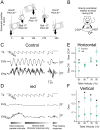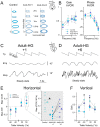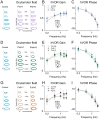Ontogeny of mouse vestibulo-ocular reflex following genetic or environmental alteration of gravity sensing
- PMID: 22808156
- PMCID: PMC3393735
- DOI: 10.1371/journal.pone.0040414
Ontogeny of mouse vestibulo-ocular reflex following genetic or environmental alteration of gravity sensing
Abstract
The vestibular organs consist of complementary sensors: the semicircular canals detect rotations while the otoliths detect linear accelerations, including the constant pull of gravity. Several fundamental questions remain on how the vestibular system would develop and/or adapt to prolonged changes in gravity such as during long-term space journey. How do vestibular reflexes develop if the appropriate assembly of otoliths and semi-circular canals is perturbed? The aim of present work was to evaluate the role of gravity sensing during ontogeny of the vestibular system. In otoconia-deficient mice (ied), gravity cannot be sensed and therefore maculo-ocular reflexes (MOR) were absent. While canals-related reflexes were present, the ied deficit also led to the abnormal spatial tuning of the horizontal angular canal-related VOR. To identify putative otolith-related critical periods, normal C57Bl/6J mice were subjected to 2G hypergravity by chronic centrifugation during different periods of development or adulthood (Adult-HG) and compared to non-centrifuged (control) C57Bl/6J mice. Mice exposed to hypergravity during development had completely normal vestibulo-ocular reflexes 6 months after end of centrifugation. Adult-HG mice all displayed major abnormalities in maculo-ocular reflexe one month after return to normal gravity. During the next 5 months, adaptation to normal gravity occurred in half of the individuals. In summary, genetic suppression of gravity sensing indicated that otolith-related signals might be necessary to ensure proper functioning of canal-related vestibular reflexes. On the other hand, exposure to hypergravity during development was not sufficient to modify durably motor behaviour. Hence, 2G centrifugation during development revealed no otolith-specific critical period.
Conflict of interest statement
Figures






References
-
- Angelaki DE, Cullen KE. Vestibular system: the many facets of a multimodal sense. Annu Rev Neurosci. 2008;31:125–150. doi: 10.1146/annurev.neuro.31.060407.125555. - DOI - PubMed
-
- Straka H, Holler S, Goto F. Patterns of canal and otolith afferent input convergence in frog second-order vestibular neurons. J Neurophysiol. 2002;88:2287–2301. doi: 10.1152/jn.00370.2002. - DOI - PubMed
-
- Bush GA, Perachio AA, Angelaki DE. Encoding of head acceleration in vestibular neurons. I. Spatiotemporal response properties to linear acceleration. J Neurophysiol. 1993;69:2039–2055. - PubMed
-
- Uchino Y, Sasaki M, Sato H, Bai R, Kawamoto E. Otolith and canal integration on single vestibular neurons in cats. Exp Brain Res. 2005;164:271–285. doi: 10.1007/s00221-005-2341-7. - DOI - PubMed
-
- Morishita H, Hensch TK. Critical period revisited: impact on vision. Curr Opin Neurobiol. 2008;18:101–107. doi: 10.1016/j.conb.2008.05.009. - DOI - PubMed
Publication types
MeSH terms
LinkOut - more resources
Full Text Sources
Medical
Molecular Biology Databases

